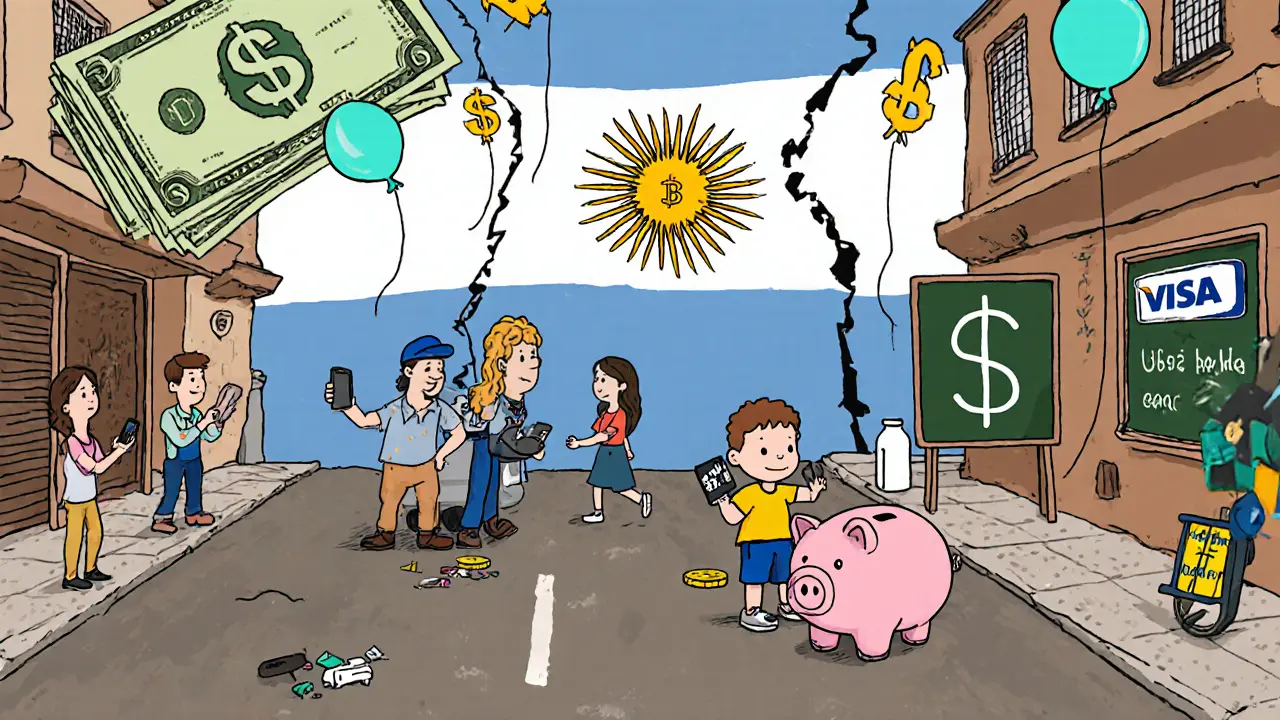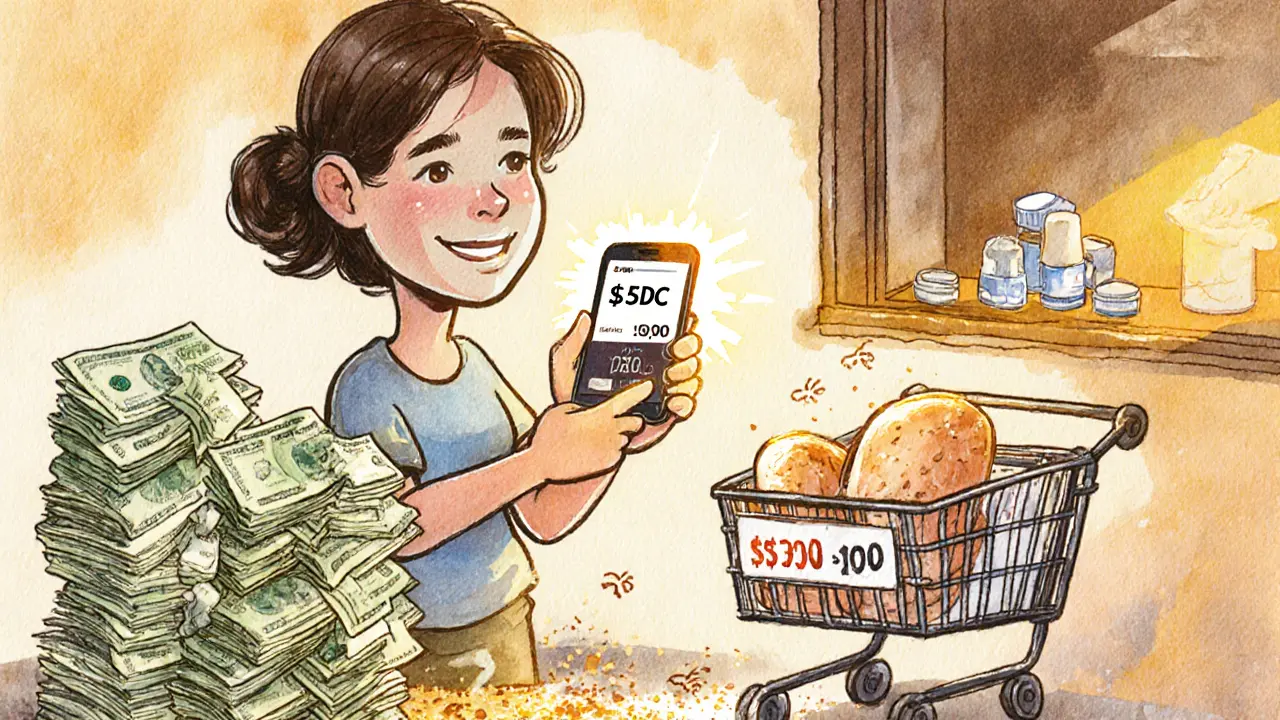Inflation Protection Calculator
How Inflation Eats Your Savings
Calculate how your local currency loses value over time and how stablecoins like USDC can help preserve your purchasing power.
Note: This tool uses Argentina's current economic situation as a reference point. Actual rates may vary.
Your Savings Details
Your Purchasing Power Analysis
Current Value: $800,000
When your peso loses half its value in a year, you don’t wait for the government to fix it
Every month, Maria, a teacher in Córdoba, gets paid 800,000 Argentine pesos. By the time she gets to the store two weeks later, that money buys 30% less. Groceries, medicine, bus fare - everything costs more. She used to keep cash under her mattress. Then she tried dollar bills. But buying dollars legally? Nearly impossible. The banks won’t let her. The government won’t let her. So she did what millions of Argentines have done: she opened the Lemon app and converted her paycheck into USDC.
That’s not speculation. That’s survival.
Argentina’s inflation didn’t spike overnight. It’s been crawling up for decades. In 2023, prices rose 161%. By May 2025, it was still at 43.5% - more than 10 times the global average. The peso has lost over 90% of its value since 2018. People aren’t investing in crypto. They’re saving their next meal in it.
Stablecoins are the new dollar
Bitcoin gets the headlines. But in Argentina, it’s not the main player. The real heroes are stablecoins: USDT, USDC, and DAI. These aren’t speculative bets. They’re digital versions of the U.S. dollar - pegged to it, backed by it, designed to stay at $1 no matter how wild the peso gets.
Why not just buy dollars? Because you can’t. Argentina has strict capital controls. You can’t open a U.S. bank account. You can’t transfer money abroad without jumping through bureaucratic hoops that take weeks and cost a fortune. Stablecoins bypass all that. You buy them with pesos on your phone. You hold them in a wallet. You spend them later - even at the corner grocery, thanks to prepaid Visa cards linked to your crypto balance.
Lemon, a local fintech startup, made this easy. You get paid in pesos. You tap a button. Your salary turns into USDC. When you need to buy bread, you tap again. Your USDC becomes pesos at the register. No bank. No waiting. No fees. Just digital dollars you can touch.
DAI is another favorite. It’s not backed by dollars. It’s backed by crypto collateral locked on the Ethereum blockchain. Argentines like it because the system is open. Anyone can check how much collateral backs each DAI. No central bank can suddenly devalue it. No politician can freeze it. It’s math, not politics.
It’s not about getting rich. It’s about not going broke
Most people in Argentina don’t buy crypto to flip it. They don’t trade Bitcoin on weekends hoping to get rich. They buy it to keep what they already have.
A 2024 Chainalysis report showed Argentina leads Latin America in crypto adoption, with nearly 20% of the population using digital assets. That’s more than Brazil. More than El Salvador, which made Bitcoin legal tender. Why? Because in Argentina, crypto isn’t a trend. It’s a necessity.
Carlos Torres from EY says it plainly: “The adoption is driven by inflation, economic instability, and currency volatility.” People aren’t chasing returns. They’re chasing stability. They’re choosing something that doesn’t vanish overnight.
Even small businesses use it. A mechanic in Rosario might charge in USDT. A freelance designer in Mendoza invoices in USDC. A family sends money to a relative in Spain using DAI - done in minutes, for under a dollar in fees. Traditional remittance services like Western Union? They charge 10% or more. And they take days.
Remittances from Argentines abroad hit $156 billion in 2023. That’s not just tourism money. That’s survival. And crypto is how it flows.

The rules changed - and it made things safer
For years, crypto in Argentina lived in a gray zone. No one banned it. No one regulated it. People used it anyway.
That changed in March 2025. The National Securities Commission (CNV), Argentina’s financial watchdog, issued Resolution 1058/2025. For the first time, crypto exchanges, wallets, and trading platforms had to register, follow anti-money laundering rules, and report transactions. It wasn’t a crackdown. It was a formalization.
President Javier Milei, who took office in December 2023, has been openly pro-crypto. He calls the peso “a scam” and supports Bitcoin as a legal alternative. His government isn’t trying to kill crypto. It’s trying to make it work.
Now, platforms like Binance and Lemon operate under clear rules. Users know who they’re dealing with. If something goes wrong, there’s a regulator to turn to. That’s huge. Trust matters when you’re putting your life savings into a digital wallet.
How it actually works - step by step
You don’t need to be a tech expert. Here’s how most Argentines do it:
- You get paid in pesos - either via direct deposit or cash.
- You open an app like Lemon, Binance, or Ripio.
- You transfer your pesos to the platform (usually within minutes).
- You buy USDC or DAI. The app converts your pesos at the real market rate.
- Your stablecoins sit in your digital wallet. They don’t lose value.
- When you need to spend, you use a linked Visa card. The app converts your USDC back to pesos at the point of sale.
- Or, you send USDC to a family member in the U.S. or Spain. They cash out in dollars - no bank delays.
No paperwork. No bank visits. No waiting. Just a phone and a Wi-Fi signal.

It’s not perfect - but it’s better than the alternatives
There are risks. If the platform shuts down, you could lose access. If you lose your password, your money is gone. If you send crypto to the wrong address, there’s no undo button.
But here’s the thing: the peso is worse.
Bank accounts? The government can freeze them. Banks can limit withdrawals. The central bank can print more money - and you lose value without warning. Crypto doesn’t have those problems. It’s decentralized. It’s global. It’s yours.
And it’s working. Over $91 billion in crypto flowed into Argentina in 2024. That’s not gambling money. That’s savings. That’s security. That’s people choosing a system that doesn’t lie to them.
What’s next? The ripple effect
Argentina isn’t just using crypto. It’s building a new financial layer on top of its broken system. Startups are popping up to help people buy, store, and spend crypto. Schools are teaching it. Local governments are exploring crypto payments for public services.
Other countries are watching. Venezuela. Nigeria. Turkey. All with high inflation. All with currency controls. All with people looking for a way out.
Argentina didn’t invent crypto. But it showed the world how to use it when everything else fails. It didn’t wait for permission. It didn’t wait for a bailout. It built its own safety net - one USDC at a time.
When your money loses value faster than you can spend it, you don’t ask for help. You find a better way. Argentines did. And now, millions sleep a little easier at night.

This is wild 😍 I had no idea people were using crypto like this just to buy bread. The peso is a joke, but USDC? That’s next-level survival mode. 🙌
I’ve read a lot about Argentina’s inflation, but seeing it through Maria’s eyes really hits different. It’s not about getting rich-it’s about not losing everything you worked for. That’s human resilience right there.
It’s amazing how tech can fill gaps governments refuse to fix. Stablecoins aren’t perfect, but they’re way better than watching your salary evaporate before you even get to the grocery store.
I live in India-we’ve got our own currency chaos, but nothing like this. Still, I feel this. When your money feels like tissue paper, you grab whatever sticks. Crypto isn’t magic-it’s just less broken than the alternatives. 🙏
So people are risking their life savings on apps because the government is incompetent? Shocking. 🙄
I love how this isn’t about speculation-it’s about dignity. People aren’t gambling; they’re protecting their ability to feed their families. That’s not crypto culture. That’s human culture.
LMAO the peso is a scam? Bro, the whole system is a dumpster fire. They should’ve just gone full Bitcoin years ago. Now everyone’s using USDC like it’s Monopoly money. Classic.
This gave me chills 😭 I mean… imagine having to turn your paycheck into digital dollars just to keep your kid’s medicine from costing twice as much next week. We take so much for granted.
There’s a quiet revolution happening here. Not in boardrooms or stock markets-but in kitchens and school drop-offs. People are rebuilding trust, one USDC transfer at a time. No flags. No speeches. Just action.
This is what decentralization looks like in practice. Not as a tech fantasy, but as a lifeline. When institutions fail, people don’t wait for permission-they build alternatives. Argentina didn’t invent crypto, but they redefined its purpose.
This is irresponsible. People should rely on institutions not apps run by anonymous devs. What happens when the platform collapses? Or the government cracks down? This is financial anarchy dressed up as innovation.
Let’s be real. This isn’t about inflation. It’s about the New World Order using crypto to track every transaction. The CNV’s ‘regulation’? A backdoor for surveillance. They want to know who’s holding dollars. They want to know who’s resisting. Don’t be fooled.
The notion that stablecoins are ‘better than the peso’ ignores the fundamental truth: money derives its value from trust in a central authority. Stablecoins are only as stable as the companies holding the reserves-and those companies are subject to U.S. regulatory whims. USDC is not money. It’s a promise. And promises can be broken. The peso, at least, is transparently worthless. At least you know where you stand with hyperinflation. With crypto, you’re trusting a black box controlled by Silicon Valley. That’s not freedom. It’s just a different kind of dependence.
I get what you’re saying, but… when your bank freezes your account and your salary buys half a bag of rice, do you really care if the black box is in Silicon Valley or Buenos Aires? I’d rather trust code than a politician who prints money like confetti. 🤷♀️